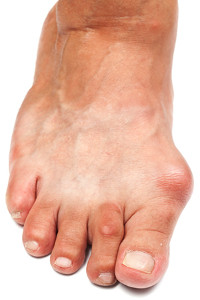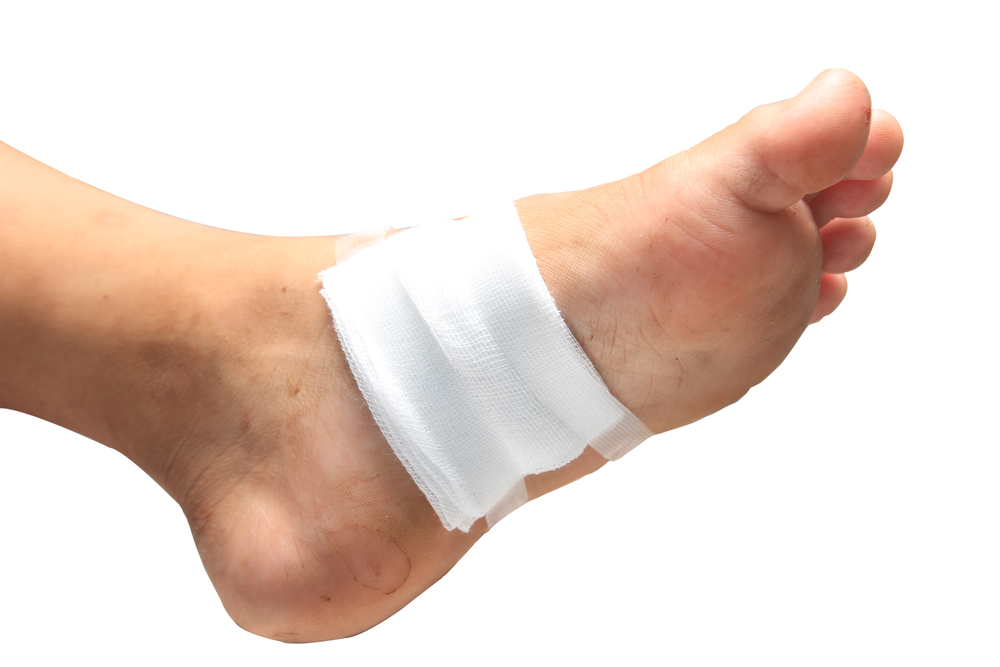 A common foot condition that is known as plantar fasciitis will often produce pain and discomfort in the heel area of the foot. This occurs as a result of excessive pressure that is gradually put on the heels, if the calf muscles are not properly stretched. Runners who increase their distance or running speed too quickly can develop stress fractures. If you unexpectedly step off a curb, your ankle can roll inward, resulting in an ankle sprain. The Achilles tendon connects the heel bone to the calf muscles, and if this should become torn, it is possible that Achilles tendinitis will develop. If you had an injury that has caused foot pain, it is advised that you speak to a podiatrist as quickly as possible, so a proper diagnosis can be determined.
A common foot condition that is known as plantar fasciitis will often produce pain and discomfort in the heel area of the foot. This occurs as a result of excessive pressure that is gradually put on the heels, if the calf muscles are not properly stretched. Runners who increase their distance or running speed too quickly can develop stress fractures. If you unexpectedly step off a curb, your ankle can roll inward, resulting in an ankle sprain. The Achilles tendon connects the heel bone to the calf muscles, and if this should become torn, it is possible that Achilles tendinitis will develop. If you had an injury that has caused foot pain, it is advised that you speak to a podiatrist as quickly as possible, so a proper diagnosis can be determined.
Foot and ankle trauma is common among athletes and the elderly. If you have concerns that you may have experienced trauma to the foot and ankle, consult with one of our podiatrists from San Antonio New Step. Our doctors will assess your condition and provide you with quality foot and ankle treatment.
Foot and ankle trauma cover a range of injuries all over the foot; common injuries include:
Symptoms
Symptoms of foot and ankle injuries vary depending on the injury, but more common ones include:
Diagnosis
To properly diagnose the exact type of injury, podiatrists will conduct a number of different tests. Some of these include sensation and visual tests, X-rays, and MRIs. Medical and family histories will also be taken into account.
Treatment
Once the injury has been diagnosed, the podiatrist can than offer the best treatment options for you. In less severe cases, rest and keeping pressure off the foot may be all that’s necessary. Orthotics, such as a specially made shoes, or immobilization devices, like splints or casts, may be deemed necessary. Finally, if the injury is severe enough, surgery may be necessary.
If you have any questions, please feel free to contact one of our offices located in San Antonio, TX. We offer the newest diagnostic and treatment technologies for all your foot care needs.
Read more about Foot and Ankle Trauma A bone that extends on the side of the big toe is referred to as a bunion. A common reason for this condition to develop can come from wearing shoes that do not provide adequate room for the toes to move freely in. The toes may shift, and one toe may overlap the other. The toes have limited space to move around in, and this may result in cramping. There are other factors that can contribute to the development of bunions, which includes genetics or arthritis. Mild relief may be found when the correct size shoes are worn, and this is helpful in preventing pressure that is put on the bunion. When this condition exists, a diagnosis is performed, which includes having an X-ray, MRI, or ultrasound taken. If you have developed a bunion, it is strongly suggested that you seek the counsel of a podiatrist who can properly treat this ailment.
A bone that extends on the side of the big toe is referred to as a bunion. A common reason for this condition to develop can come from wearing shoes that do not provide adequate room for the toes to move freely in. The toes may shift, and one toe may overlap the other. The toes have limited space to move around in, and this may result in cramping. There are other factors that can contribute to the development of bunions, which includes genetics or arthritis. Mild relief may be found when the correct size shoes are worn, and this is helpful in preventing pressure that is put on the bunion. When this condition exists, a diagnosis is performed, which includes having an X-ray, MRI, or ultrasound taken. If you have developed a bunion, it is strongly suggested that you seek the counsel of a podiatrist who can properly treat this ailment.
If you are suffering from bunions, contact one of our podiatrists of San Antonio New Step. Our doctors can provide the care you need to keep you pain-free and on your feet.
What Is a Bunion?
A bunion is formed of swollen tissue or an enlargement of boney growth, usually located at the base joint of the toe that connects to the foot. The swelling occurs due to the bones in the big toe shifting inward, which impacts the other toes of the foot. This causes the area around the base of the big toe to become inflamed and painful.
Why Do Bunions Form?
Genetics – Susceptibility to bunions are often hereditary
Stress on the feet – Poorly fitted and uncomfortable footwear that places stress on feet, such as heels, can worsen existing bunions
How Are Bunions Diagnosed?
Doctors often perform two tests – blood tests and x-rays – when trying to diagnose bunions, especially in the early stages of development. Blood tests help determine if the foot pain is being caused by something else, such as arthritis, while x-rays provide a clear picture of your bone structure to your doctor.
How Are Bunions Treated?
If you have any questions, please feel free to contact one of our offices located in San Antonio, TX. We offer the newest diagnostic and treatment technologies for all your foot care needs.
Read more about What Are Bunions? A condition that is known as ingrown toenails may be a result of the toenail growing into the surrounding skin. The big toe is typically affected, and can cause pain and discomfort. There are several symptoms that may be associated with this condition, including possible discharge, redness and irritation around the toe, and pain when the toe is touched. There are many reasons why this ailment might develop. These may include toenails that have been trimmed incorrectly, wearing shoes that may be too tight, or an injury that may have happened to the toe. If you have an ingrown toenail, it may be helpful to gently push the affected skin away from the nail. If it should become infected, it is advised that you consult a podiatrist who can discuss the best treatment options for you.
A condition that is known as ingrown toenails may be a result of the toenail growing into the surrounding skin. The big toe is typically affected, and can cause pain and discomfort. There are several symptoms that may be associated with this condition, including possible discharge, redness and irritation around the toe, and pain when the toe is touched. There are many reasons why this ailment might develop. These may include toenails that have been trimmed incorrectly, wearing shoes that may be too tight, or an injury that may have happened to the toe. If you have an ingrown toenail, it may be helpful to gently push the affected skin away from the nail. If it should become infected, it is advised that you consult a podiatrist who can discuss the best treatment options for you.
Ingrown toenails may initially present themselves as a minor discomfort, but they may progress into an infection in the skin without proper treatment. For more information about ingrown toenails, contact one of our podiatrists of San Antonio New Step. Our doctors can provide the care you need to keep you pain-free and on your feet.
Ingrown Toenails
Ingrown toenails are caused when the corner or side of a toenail grows into the soft flesh surrounding it. They often result in redness, swelling, pain, and in some cases, infection. This condition typically affects the big toe and may recur if it is not treated properly.
Causes
You are more likely to develop an ingrown toenail if you are obese, have diabetes, arthritis, or have any fungal infection in your nails. Additionally, people who have foot or toe deformities are at a higher risk of developing an ingrown toenail.
Symptoms
Some symptoms of ingrown toenails are redness, swelling, and pain. In rare cases, there may be a yellowish drainage coming from the nail.
Treatment
Ignoring an ingrown toenail can have serious complications. Infections of the nail border can progress to a deeper soft-tissue infection, which can then turn into a bone infection. You should always speak with your podiatrist if you suspect you have an ingrown toenail, especially if you have diabetes or poor circulation.
If you have any questions, please feel free to contact one of our offices located in San Antonio, TX. We offer the newest diagnostic and treatment technologies for all your foot care needs.
Read more about Ingrown Toenails Patients who are overweight may experience heel pain; and in severe cases, this may lead to disability. Practicing a routine exercise regimen is generally helpful in shedding additional weight, but heel pain can prevent regular exercise from occurring. Plantar fasciitis can be common among overweight patients, and chronic foot pain may become worse if the weight should increase. The weight of the body is generally kept off the heels while cycling and swimming, and these aerobic exercises may be helpful in losing weight. If you are experiencing obesity and would like additional information about how excess weight can affect the feet, speak to your podiatrist.
Patients who are overweight may experience heel pain; and in severe cases, this may lead to disability. Practicing a routine exercise regimen is generally helpful in shedding additional weight, but heel pain can prevent regular exercise from occurring. Plantar fasciitis can be common among overweight patients, and chronic foot pain may become worse if the weight should increase. The weight of the body is generally kept off the heels while cycling and swimming, and these aerobic exercises may be helpful in losing weight. If you are experiencing obesity and would like additional information about how excess weight can affect the feet, speak to your podiatrist.
Obesity has become very problematic at this point in time and can have extremely negative effects on the feet. If you’re an obese individual and are concerned about your feet, contact one of our podiatrists from San Antonio New Step. Our doctors can provide the care you need to keep you pain-free and on your feet.
Obesity and Your Feet
Since your feet are what support your entire weight when standing, any additional weight can result in pain and swelling. Being overweight is one of the main contributors to foot complications.
Problems & Complications
Extra Weight – Even putting on just a few extra pounds could create serious complications for your feet. As your weight increases, your balance and body will shift, creating new stresses on your feet. This uneven weight distribution can cause pain, even while doing the simplest tasks, such as walking.
Diabetes – People who are overweight are at serious risk of developing type-2 diabetes, which has a drastic impact on the health of your feet. As you get older, your diabetes might worsen, which could lead to loss of feeling in your feet, sores, and bruises. You could also become more prone to various infections.
Plantar fasciitis – Pressure and stress that is placed on muscles, joints, and tendons can trigger plantar fasciitis, which is an inflammation of tissue that forms along the bottom of the foot.
If you have any questions please feel free to contact one of our offices located in San Antonio, TX. We offer the newest diagnostic and treatment technologies for all your foot and ankle needs.
Read more about How Obesity Affects Your Feet The healing process is comprised of different stages when wounds are located on the feet. It begins with blood vessels becoming constricted at the sight of the wound. This may be effective in preventing blood loss. When this is completed, collagen forms inside the wound, and this may enable the wound to close. The last stage occurs as the body produces additional collagen, and the wound will gradually disappear. There may be obstacles that exist which can prevent proper wound healing. These may include poor dietary choices, smoking, or medical conditions such as diabetes or immune disorders. When a wound develops, it is beneficial to clean the area by gently washing it, and removing any dirt that may be present. If you have a wound on your foot, it is suggested to speak to a podiatrist who can properly treat this ailment by applying the appropriate dressing, and prescribing the correct medication.
The healing process is comprised of different stages when wounds are located on the feet. It begins with blood vessels becoming constricted at the sight of the wound. This may be effective in preventing blood loss. When this is completed, collagen forms inside the wound, and this may enable the wound to close. The last stage occurs as the body produces additional collagen, and the wound will gradually disappear. There may be obstacles that exist which can prevent proper wound healing. These may include poor dietary choices, smoking, or medical conditions such as diabetes or immune disorders. When a wound develops, it is beneficial to clean the area by gently washing it, and removing any dirt that may be present. If you have a wound on your foot, it is suggested to speak to a podiatrist who can properly treat this ailment by applying the appropriate dressing, and prescribing the correct medication.
Wound care is an important part in dealing with diabetes. If you have diabetes and a foot wound or would like more information about wound care for diabetics, consult with one of our podiatrists from San Antonio New Step. Our doctors will assess your condition and provide you with quality foot and ankle treatment.
What Is Wound Care?
Wound care is the practice of taking proper care of a wound. This can range from the smallest to the largest of wounds. While everyone can benefit from proper wound care, it is much more important for diabetics. Diabetics often suffer from poor blood circulation which causes wounds to heal much slower than they would in a non-diabetic.
What Is the Importance of Wound Care?
While it may not seem apparent with small ulcers on the foot, for diabetics, any size ulcer can become infected. Diabetics often also suffer from neuropathy, or nerve loss. This means they might not even feel when they have an ulcer on their foot. If the wound becomes severely infected, amputation may be necessary. Therefore, it is of the upmost importance to properly care for any and all foot wounds.
How to Care for Wounds
The best way to care for foot wounds is to prevent them. For diabetics, this means daily inspections of the feet for any signs of abnormalities or ulcers. It is also recommended to see a podiatrist several times a year for a foot inspection. If you do have an ulcer, run the wound under water to clear dirt from the wound; then apply antibiotic ointment to the wound and cover with a bandage. Bandages should be changed daily and keeping pressure off the wound is smart. It is advised to see a podiatrist, who can keep an eye on it.
If you have any questions, please feel free to contact one of our offices located in San Antonio, TX. We offer the newest diagnostic and treatment technologies for all your foot care needs.
Read more about Wound Care